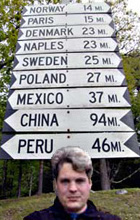Subscribe to the blog 
|
 |
 |
 |
 |
 |
Find a Flight Consider a Consolidator Rent a Car Pick a Railpass Book a Vacation Reserve a Room Get Gear |
|
||||||
|
People Who Live on Glass Islands (cont'd) << back Venetians brave the hellish weather to make a pilgrimage here with clutches of candles firmly in hand, ready to surrender them inside the church to a member of the altar boy squadrons. The altar boys' job on this day is to dash about the pair of tiny, candelabra-filled corrals flanking the stairs to the high altar, grabbing up those prayer candles from the faithful and lighting them from already-burning ones. They place each fresh candle in an empty holder on a heavily laden, industrial-sized candelabra before yanking out several others — after the smoke has had a few moments to carry the supplicant's prayer (for the health of a loved one) up to heaven — so as to make room for the next prayer in the candle queue. These adolescents work feverishly and with precision, bathed in the sort of soft, warm, orangey-yellow candle glow that illuminates Flemish paintings. Their prayer candles successfully bivouacked in a candelabra, the faithful in their fur coats and wool scarves shuffle around to attend one of the standing-room-only masses that are held, back to back, for the duration of the Holy Day. But I didn't find the most telling window into modern Venetian life in that religious Festa, or in the experience of the Acque Alte, or even in the innumerable churches, museums, and cichetti bars I visited. It was actually at Venetian inns, on those excruciating but all-important hotel tours, that I dug up the most dirt on La Serenissima. At the hotel where I spent most of my stay, Ai Do Mori, the young owner, Alessandra, and I chatted quite a bit. One day we were discussing which restaurants were still good in town — or, to be more specific, which were those where you could still eat well, and find friendly service, for a reasonable price. When the subject came up of the frightening inflation on menu prices, I started to bemoan my former favorite little trattoria, where just three years I enjoyed full meals for.... Alessandra interrupted me, "...30,000L; and now it costs seventy or eighty thousand lire." Exactly, I agreed, that's precisely what's happened. She shook her head and, after artfully talking a seedy-looking (not to mention slightly tipsy) potential guest out of wanting to stay here with his eleven friends (had they brought the whole team?), she returned to the subject at hand and lay down the rule on dining Venice. "These days, you either have to find osterie well off the tourist routes, or go to the brand-new ones, before they realize how much they can make by taking advantage of the tourists and quickly sell out," by which she meant turning to high prices, low quality, or more often both. (All this from a woman who operates the one hotel closest to Venice's main sight, the Basilica San Marco, and yet still charges some of the lowest prices in town.) Yes, it's easy to look at the evil in Venice, the overpriced Canalside Disneyland impression many tourists unfortunately leave with, especially if they stop here for only a day or two. Those who stay a bit longer start to uncover the magic of Venice, rooting out those unspoilt osterie and getting to know some of the city away from the well-trod roads where signs point tourists down the quickest (read: most overpriced shop-lined) route through the arcane twisting street pattern from San Marco to the Rialto to the Accademia and then out of town again. (I still maintain that the route along Calle dei Fabbri should be renamed "Rio dei Touristi," or 'Canal of Tourists,' for the unending flow of visitors along it, the same way the bridge just south of the Ponte dei Sospiri should be officially identified as "The Bridge of People Taking Pictures of the Bridge of Sighs," but urban planners never consult me before labeling their maps.) more >> |

